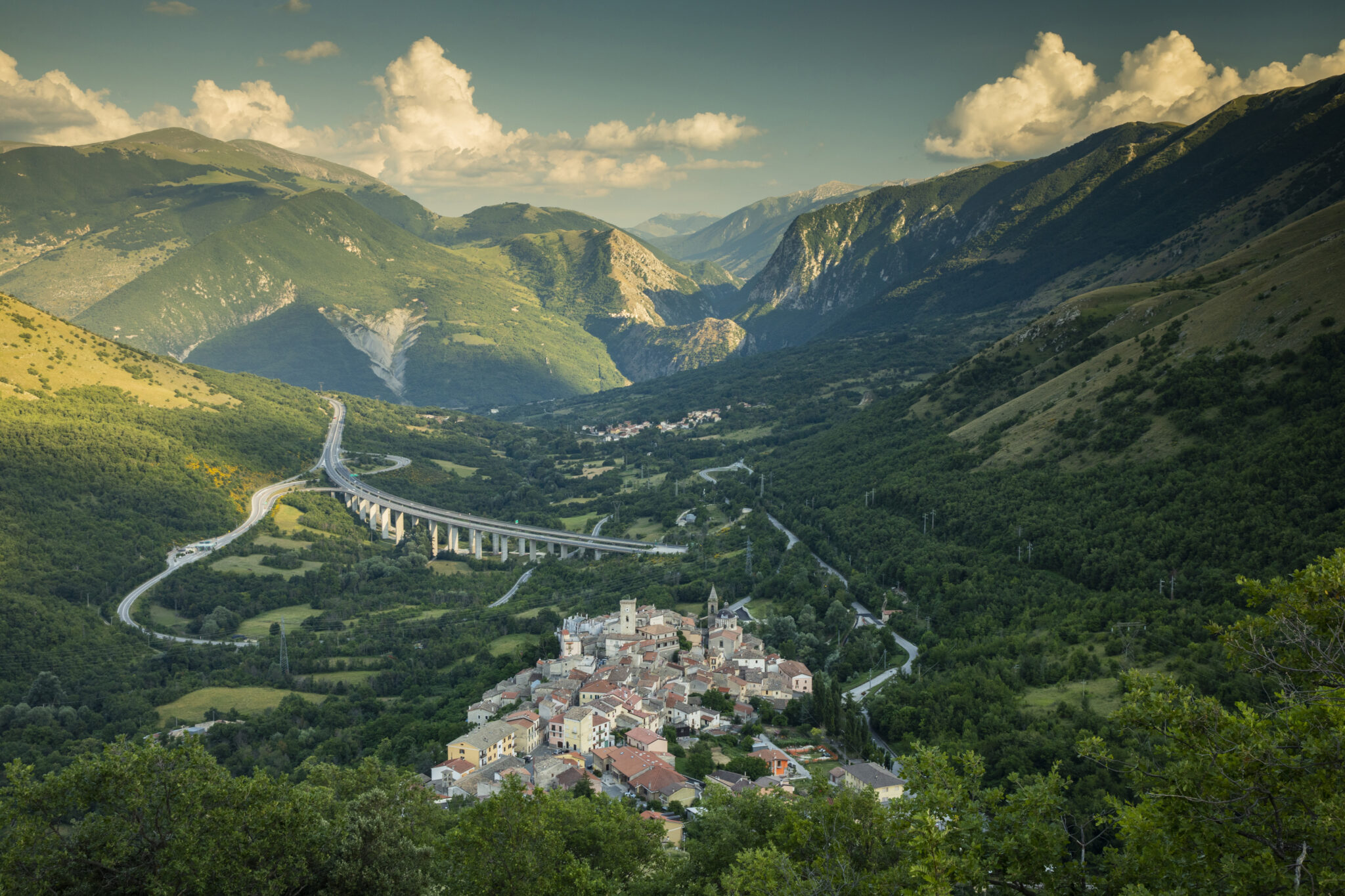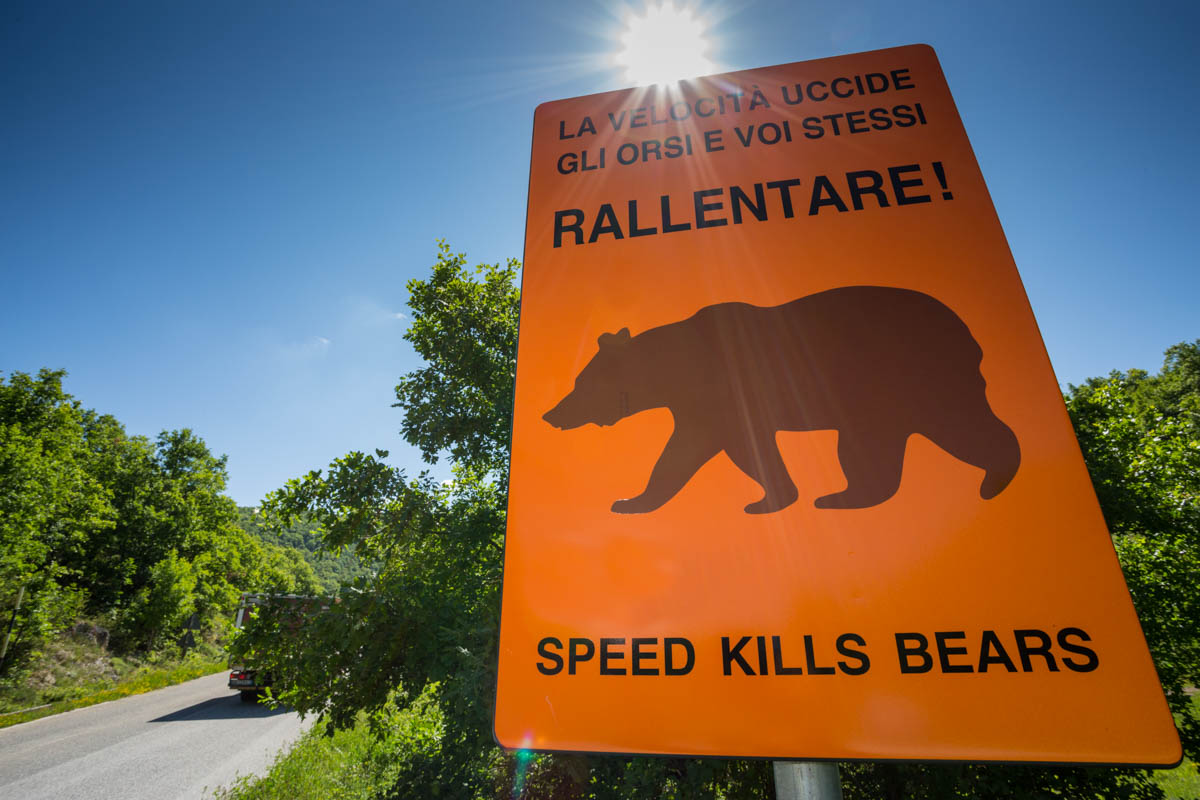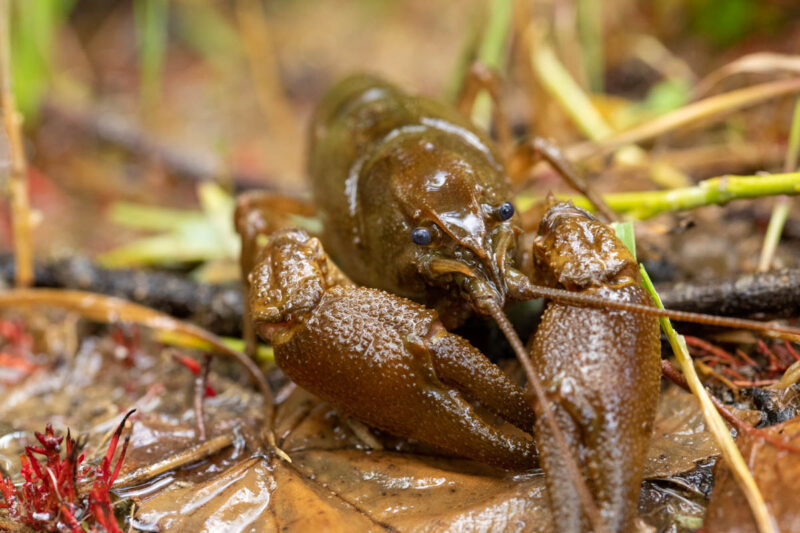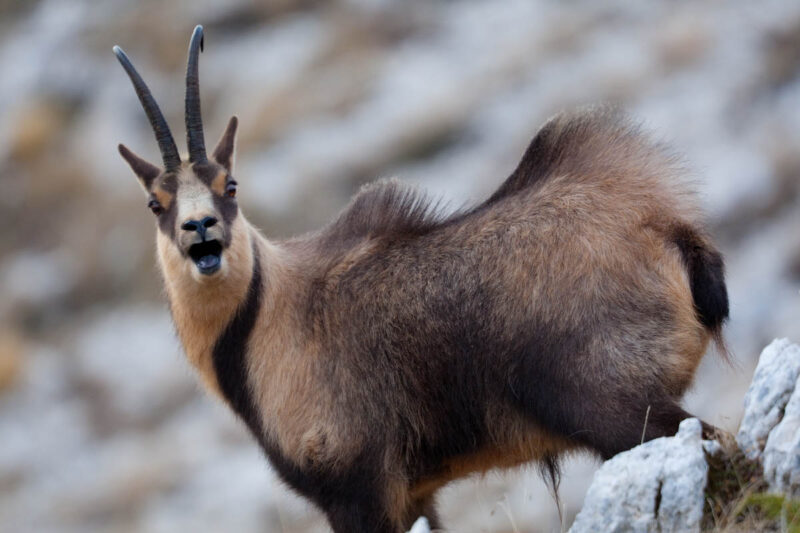Wild natural landscapes without animals are like precious museum storage without curators. We aim to reintroduce, restore populations of many wildlife species or facilitate their migration in the area, including Marsican brown bear, wolf, red deer, chamois, otters, vulture and many others.
Establishing coexistence corridors

In the Central Apennines rewilding area, we are working with Rewilding Europe and local partners to develop large “coexistence corridors” by connecting the local economy with wilder nature in five corridors collectively covering more than 100,000 hectares. This will benefit the wildlife populations, and the quality of nature and nature-related experiences, in three neighbouring protected areas – the Abruzzo, Lazio and Molise National Park, the Majella National Parks and the Sirente Velino Regional Park – together with their buffer zones.
Within these corridors local communities are learning to live alongside the spectacular wildlife of the Central Apennines, of which the Marsican brown bear is the most iconic species. By reducing the damage caused by such wildlife, and by allowing communities to benefit from it, people living here will become ambassadors for the area’s wild nature. Actions in the field are focused on reducing bear mortality and conflict, supporting nature-based enterprises in and around corridor areas, and raising awareness amongst local communities and people visiting the area.
Boosting Marsican brown bear numbers

A short drive from Rome, the dramatic Central Apennines is the final refuge of many animals and plants that were once widespread across all of Italy’s mountainous areas. Of these, the Marsican brown bear is both the most iconic and most endangered.
While the current Marsican brown bear population (numbering 50–60 individuals) is relatively safe inside the region’s nature parks (mainly the Abruzzo, Lazio and Molise National Park), outside park boundaries they are at risk from poaching, poisoning and traffic collisions. There is also conflict with local people who experience problems related to beehives, orchards and livestock, and who don’t benefit economically from the presence of the bears.

Rewilding Apennines is working with Rewilding Europe and local partners to reduce bear mortality and conflict by installing traffic accident prevention measures, removing old fencing, restoring and improving signage, distributing electric fences and bear-proof metal doors.
A group of locally recruited “bear ambassadors” has also been set up to communicate with local communities, train landowners, search for illegal snares, support anti-poison patrols, collect bear reports and manage camera traps.
Bear Smart Community model
The Bear Smart Community model encourages cooperation between local communities, businesses, and individuals to prevent conflict between bears and humans by removing any potential source of bears being attracted to urban areas. It promotes simple but effective solutions to avoid unnecessary situations caused either by the bears or to them. In the Central Apennines the few remaining Marsican bears are forced to live in territories which, while suitable and mostly protected, are characterized by a strong human presence. Preventing the conflicts between humans and bears, especially in the natural connection corridors between protected areas in order to favor the movement of bears, is therefore fundamental to rescue this subspecies from the brink of extinction. What are the recommendations for a Bear Smart Community?
Bear-proof beehives and livestock farms
Electrified fences are a barrier that prevents bears from entering an animal enclosure, a vegetable garden or even accessing beehives.
Bear-smart orchards and urban vegetable gardens
It is necessary to pick ripe fruits before the fall, and remove any fallen fruit in order to not attract the bear in the village.
Bear-smart management of organic waste and other food-attractors
Correct management of organic waste is necessary to avoid bears being attracted to waste bins.*
Bear-smart sanitary management of domestic animals
Some of the infectious diseases potentially harmful to bears can be transmitted by dogs. The transmission of these diseases can be avoided through vaccinations and correct management of dogs.
* Where there is not a door-to-door rubbish collection, the organic material waste-bins can be fitted with a special closure that is bear-proof.
* Where there is door-to-door rubbish collection, it is necessary that people keep their rubbish in the house or in the garage until the day of pick-up.
* Domestic animals’ food will need to be stored in enclosed areas that are inaccessible to bears and must never be left in gardens or close to inhabited areas.
If a community respect these best practices of behavior, the coexistence is more likely to be achieved!
Download the Manual of best practice for the coexistence with the Marsican brown bear.

Reducing the threats for wildlife
In Central Apennines one of the best ways to protect wildlife is reducing the threats coming from the human beings.Especially for the Marsican brown bear, but even for other species, these are the main risks they can be victims of:
- Poaching
- Poisoning
- Collision with vehicles
- Habitat fragmentation
- Anthropogenic disturbance
- Genetic variability and health (specifically for the endangered Marsican brown bear)
- Interactions with cattle and other domestic animals, which can transmit infectious diseases to wildlife
- Infrastructures, human activities and landscape transformations
- Lack of awareness and bureaucracy at every level of the society
Each of these direct and indirect threats on wildlife must be faced with hard work on the ground, communication and education especially dedicated to local communities, partnerships with private and public entities aiming at the same objectives, fundraising for specific projects of nature conservation and a shared long-term vision with people to mitigate human-wildlife conflict and develop nature-based solutions and activities for the future.
Enhancing wildlife
In addition to our efforts to enhance the Marsican brown bear population, our team is engaged in other conservation projects relating to Central Apennines rewilding:

White-clawed crayfish
Austropotamobius italicus meridionalis
A preliminary study has evaluated the situation of this species, protected at European level, in our mountain streams and rivers. Following this, the introduction and/or reintroduction programs of crayfish can be designed and implemented on the basis of the availability of resources and partners.

Vultures
An increasing population of griffon vultures (Gyps fulvus) in the region testifies to the enhancement of habitat conditions for other vultures’ species. We are working for their comeback.

Apennine chamois
Rupicapra pyrenaica ornata
Some of the highest peaks of the Central Apennines are inhabited by this vulnerable mountain goat. In the past decades, the Apennine chamois has been reintroduced successfully in some rocky mountain ridges of national and regional parks, however some areas are missed although are suitable for the species. Velino mountain is one our goal where to reintroduce “the most beautiful chamois of the world”, as it is defined.
Download the report “Central Apennines Rewilding Area: habitat and species assessment in a sample area“.
Our main achievements
- The road from Gioia dei Marsi to Gioia Vecchio has been equipped with wildlife warning optical reflectors and road signs to prevent bear-vehicle collisions, while speed limit was reduced from 90 km/h to 70km/h thanks to an agreement with the provincial administration on Road SR83.
- In 2014 the Rewilding Apennines team handed over 24 electric fences donated by Rewilding Europe and Fondation Segré to the citizens of Pettorano sul Gizio to protect chicken coops, stables, gardens and orchards from wildlife damage (Marsican brown bear’s damage in particular).
- Between 2014 and beginning of 2016, three people from local villages were hired as “bear ambassadors”. These people worked with livestock owners and stakeholders, managed 10 camera traps, and patrolled the area to check for instances of bear damage and poisoning.
- In 2018, in collaboration with Salviamo l’Orso, Rewilding Apennines:
- Built 30 electric fences and 6 bear-proof metal doors in the area of Pettorano sul Gizio-Sulmona with damages dramatically reduced and bears’ raids steered to “new” areas, such as the Biosphere Reserve Collemeluccio Montedimezzo Alto Molise.
- Assessed wildlife in the Gole del Sagittario with 47,600 photos from 40 camera traps taken and agreement with the Zoological Society of London for their publication on the Instant Wild platform.
- 194 fruit trees liberated from encroaching vegetation to enhance food resources for the bear in mountain areas.
- First 5 km of barbed wire removed from the project area.
- Over 40 volunteers involved in ground work.
- In 2019, Rewilding Apennines and Salviamo l’Orso:
- Removed more than 24 kilometers of barbed wire.
- Liberated 521 fruit trees from encroaching vegetation to enhance food resources for the bear in mountain areas.
- Installed 61 electric fences, 14 bear-proof metal doors and 3 bear-proof chicken houses.
- Made safe 6 remote water tanks (following the tragic drowning of a Marsican brown bear female and two cubs in November 2018).
- Ascertained that zero instances of bear damage occurred in Alto Molise coexistence corridor, following protection of livestock farms and apiaries (this was previously a problem area in terms of bear damage).
- Recorded evidence of bears feeding in abandoned orchards after trees here had been pruned by the rewilding team. Such pruning helps to reduce bear damage by diverting the animals away from orchards under cultivation.
- The Monte Genzana Alto Gizio Nature Reserve published data from 2019. With the help of the RA team and SLO volunteers, 12 different bear genotypes were detected in the Reserve territory and 5 rub trees (where usually bears leave their “territorial messages”).
- In 2020, Rewilding Apennines and Salviamo l’Orso:
- Built 51 electric fences. No damage occurred in the protected properties. Only a few bear damage events were reported in the area directly managed by the RA team, proving the efficiency of the preventive measures and the staff (including volunteers). No damage at all occurred in the Bear Smart Community Genzana and in the Bear Smart Community Alto Molise. Only two bear damage events were reported in the Bear Smart Community Valle Roveto, mainly to unprotected apiaries.
- Reintroduction of the European freshwater crayfish: a feasibility study for the reintroduction of this endemic species was delivered by Dr. Tommaso Pagliani. Three rivers in the corridors have been inspected and assessed for the possible future crayfish restock and release of the individuals.
- Reintroduction of the Apennine chamois in the Velino mountains and monitoring:in collaboration with Forestry Carabinieri (a Police Corp that deals with environmental crimes and that is dedicated to the management and surveillance of the State Reserves) with Rewilding Apennines commitment to provide at least 10 GPS collars.
- In 2021, Rewilding Apennines and Salviamo l’Orso:
-
- Installed 65 bear damage preventative devices: 55 electric fences and 10 bear-proof metal doors. As a result no damages were reported in the Bear Smart Community Genzana and in the Bear Smart Community Alto Molise.
- 24 km of barbed wire were removed
- 6 water tanks were secured for the protection of wildlife and people
- Rewilding Apennines signed a partnership agreement with Reparto Carabinieri Biodiversità Castel di Sangro to better understand and protect the griffon vulture population of the Central Apennines. In 2021, together we investigated 380 roosting and carcass locations and equipped 33 individuals with GPS transmitters. New funding secured from the European Outdoor Conservation Association will enable us to scale up our monitoring actions, which investigate and address the main threats for this species.
- We are continuing work to reinforce the population of the Apennine chamois in the Sirente Mountain and begin a reintroduction process in the Monte Velino State Reserve with the collaboration of Reparto Carabinieri Biodiversità di Castel di Sangro and the Sirente Velino Regional Park and a thanks to a grant from La Passerelle Conservation Foundation and Parc Animalierd Auvergne.
- Two tanks for the crayfish breeding centre were set up in Morino in collaboration with the Zompo Lo Schioppo Nature Reserve and discussions were initiated for the opening of other breeding centers which would boost their population in three rivers.